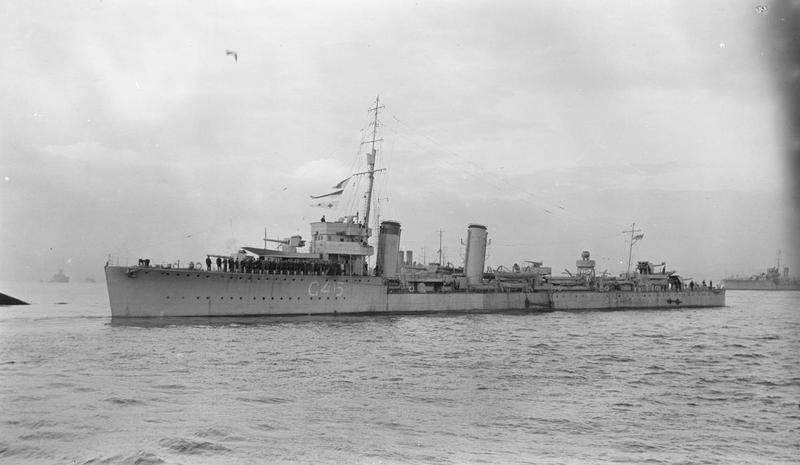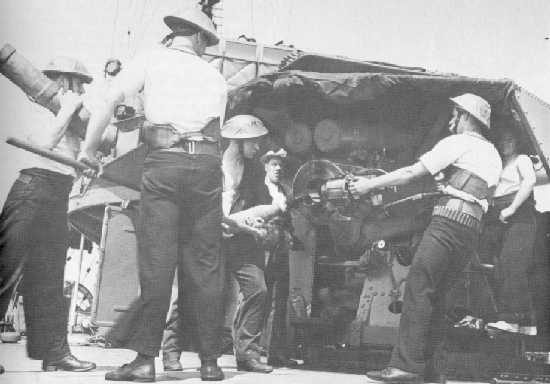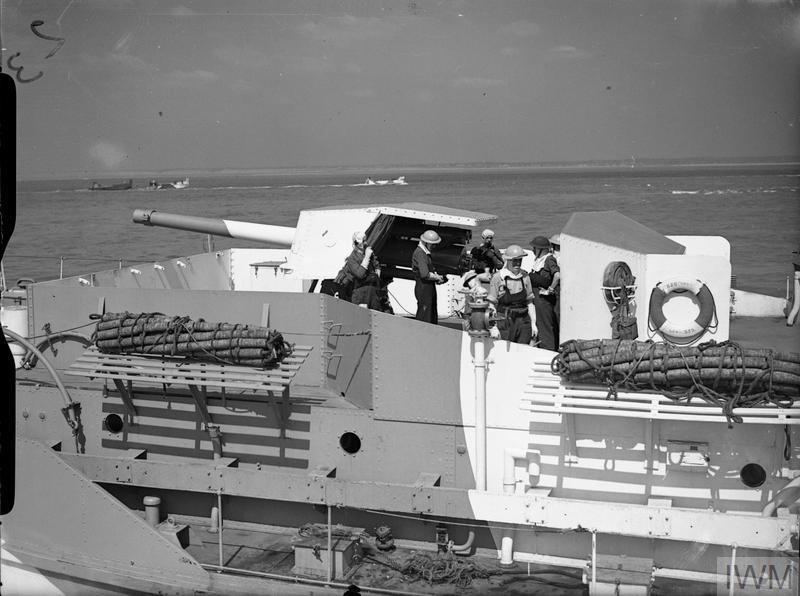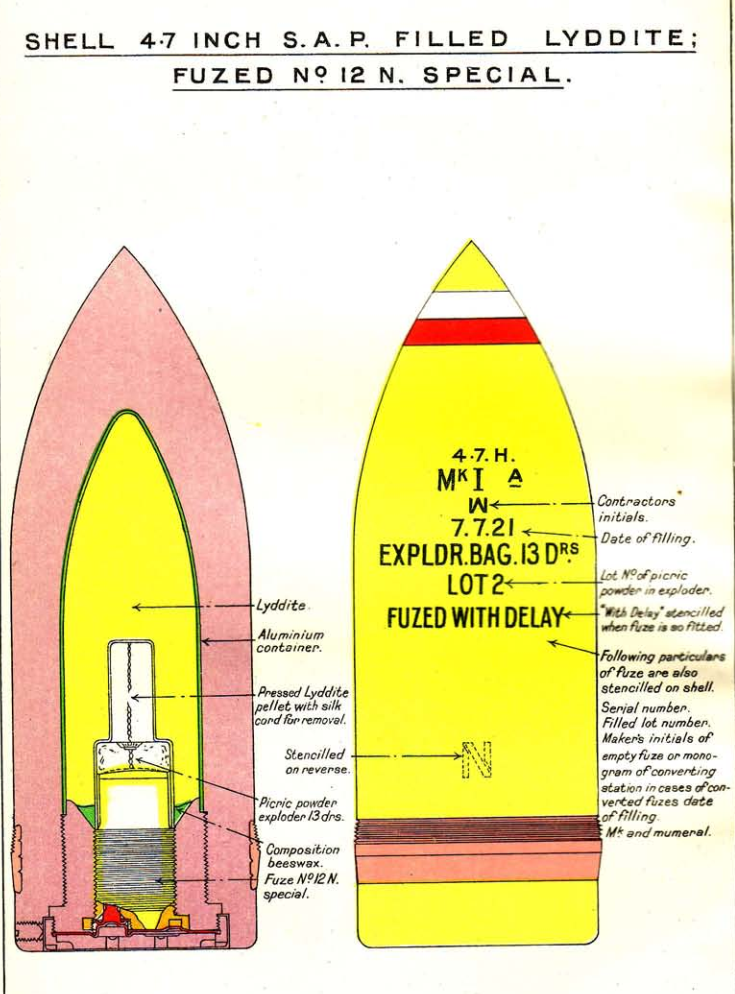
The Mark I was designed hurriedly late in World War I as a response to reports that the Germans were arming their new destroyers with heavier guns than the 10.5 cm (4.1") weapons previously used. In fact, the Germans had armed a few destroyers with 15 cm (5.9") guns, but the Armistice intervened before any of these saw active service. This program gave the Royal Navy some of the most powerful destroyers in the world at the end of World War I.
The mountings for these guns can be distinguished from later 4.7" (12 cm) QF mountings by their abbreviated shields, which offered little protection to their gun crews' legs. These open-back gun mounts with their lack of integral hoists and low maximum elevations formed the pattern for the main guns used on nearly all British destroyers for the next three decades.
By 1940, many of these weapons were wearing out and the ones that remained were almost all mounted on obsolescent warships. Rather than simply replacing these worn-out Mark I guns with a similar, already available weapon such as the 4.7"/45 (12 cm) QF Mark IX, the British instead wasted scarce resources to design and manufacture a new, direct replacement gun of modern construction techniques, the Mark II. I can think of no better illustration of just how low a priority the Royal Navy assigned to ordnance standardization prior to the 1950s.
Mark I was constructed of a tapered inner A tube, A tube, full length wire and a full length jacket. Mark I* was the same with no inner A tube. Mark II had a monobloc barrel, breech ring and breech bush. All of these were interchangeable and used a Welin breech block with a Vickers mechanism. A total of 187 Mark I and Mark I* guns were completed out of 776 ordered during World War I. Of these, 176 were available in 1939. 32 Mark II guns were ordered in 1940 and all were completed during the war.
The 4.7" (12 cm) caliber was used on almost every destroyer built by Britain between 1917 and 1943.
Actual bore diameter of all British 4.7" guns was 4.724" (12 cm).
| Designation | 4.7"/45 (12 cm) BL Mark I
4.7"/45 (12 cm) BL Mark II |
|---|---|
| Ship Class Used On | 1918 - 1919
Scott, Shakespeare and Modified V&W classes Botha class as rearmed 1929
1939 - 1945
|
| Date Of Design | Mark I: 1918
Mark II: 1940 |
| Date In Service | Mark I: 1919
Mark II: 1940 |
| Gun Weight | Mark I: 7,000 lbs. (3,175 kg)
Mark II: 7,028 lbs. (3,188 kg) |
| Gun Length oa | 219.8 in (5.582 m) |
| Bore Length | 212.6 in (5.400 m) |
| Rifling Length | Probably 179.3 in (4.552 m) 1 |
| Grooves | Probably (38) 0.037 in deep x 0.270 (0.94 x 6.86 mm) 1 |
| Lands | Probably 0.1205 in (3.061 mm) 1 |
| Twist | Probably Uniform RH 1 in 30 1 |
| Chamber Volume | 665 in3 (10.90 dm3) |
| Rate Of Fire | 5 - 6 rounds per minute |
- ^1.11.21.31.4The Rifling Length, Grooves, Lands and Twist dimensions given above are those for the 4.7"/45 (12 cm) Mark IX. As these guns fired the same projectiles did as that weapon, it seems probable that they shared similar dimensions for these characteristics.
| Type | Bag |
|---|---|
| Projectile Types and Weights | HE - 50 lbs. (22.68 kg)
SAP - 50 lbs. (22.68 kg) Illum - N/A |
| Bursting Charge | N/A |
| Projectile Length | N/A |
| Propellant Charge | 11.45 lbs. (5.19 kg) SC 103
13.78 lbs. (6.25 kg) NF/S 164-048 |
| Muzzle Velocity | 2,670 fps (814 mps) |
| Working Pressure | N/A |
| Approximate Barrel Life | N/A |
| Ammunition stowage per gun 1a | N/A |
- ^Outfits included SAP, HE and 40 - 50 star shells per ship unless on escort duty, in which case star shell complement was increased to 150 - 200.
| Elevation | Range |
|---|---|
| 30 degrees | 15,800 yards (14,450 m) |
| Designation 1b | Single open mounts
Scott (5) and Shakespeare (5): CPVI Modified V&W (4): CPVI* Amazon (4), Ambuscade (4), Mistral (4) and Ouragan (4): CPVI** Others: N/A |
|---|---|
| Weight | about 8 tons (8.1 mt) |
| Elevation | -9.5 / +30 degrees |
| Elevation Rate | Manually operated, only |
| Train | about +120 / -120 degrees |
| Train Rate | Manually operated, only |
| Gun recoil | N/A |
- ^Many older destroyers were converted to long-range convoy escorts during World War II and had two or more guns removed in order to fit them with additional fuel tanks and ASW equipment.



"Naval Weapons of World War Two" and "British Naval Guns 1880-1945 No 15" article in "Warship Volume IX" both by John Campbell
"Naval Radar" by Norman Friedman
"Torpedo Warfare: A Successful Prediction" article by D.J. Lyon in "Warship Volume VII"
"British Battleships of World War Two" by Alan Raven and John Roberts
"Destroyers of World War Two" by M.J. Whitley
---
"O.U. 5267: Ammunition Pocket Book - 1924" by Admiralty, S.W. Gunnery Branch
---
Special help from Rod Butcher
---
Tony DiGiulian's personal files
27 February 2007 - Benchmark
12 February 2012 - Updated to latest template
03 February 2014 - Added photograph of Stuart
25 May 2014 - Minor change to photograph caption
18 December 2016 - Converted to HTML 5 format
23 June 2021 - Added sketch of SAP projectile
06 November 2021 - Corrected typographical error, reorganized notes
